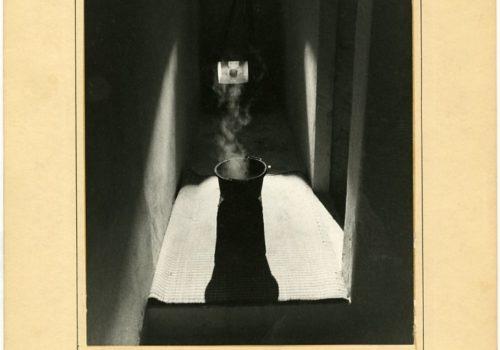Deborah Bell Photographs presents Conceptual Matters, an exhibition of photographs depicting artworks by artists of the late 1960s-1970s who pushed the boundaries of visual perception in performance, land art, conceptually-based body art, and photography.
The 1960s introduced after Pop Art several non-narrative movements in the plastic arts including Minimalism, color-field painting, and a renewed appreciation of Assemblage. “Happenings” of the late 1950s, and the interest in dance as a form of sculptural art in space and time, evolved in the 1970s into performance art, in which artists used themselves as the carrier of the idea. Feminist content entered these artistic discussions, and artists began to use photography in order to illustrate ideas or to record an ephemeral event, thus melding photography with the fine arts. “Conceptual” and “Environmental” art challenged the dominance of painting and upended traditional sculpture-making by its use of materials such as dust and soil, or deriving its subject matter from literature and theater. Intellectual explorations in land art and body art displaced the permanent sculptural object. The photograph — whether the product of a still, video, or film camera — was often the only evidence remaining since many of the artworks were temporary structures or momentary actions.
The authors of the renowned textbook, American Art (Abrams, 1979), astutely suggest reasons for this confluence of artistic practices and mediums, and the turn toward the conceptual approach in art: “The change came (to some extent) in reaction to the commercialism of the art scene in the 1960s. The accelerated pace of innovation may have reflected the widespread sense of social despair and of governmental incapacity to halt wars or assure human survival in the poisoned atmosphere of planet earth. This new mood of global pessimism probably contributed to artistic innovation and the uninhibited risk-taking apparent on all sides. By the 1970s,…with the termination of the Vietnam conflict, the zeitgeist in America began to change. The sense of commitment of the 1960s turned to the post-Watergate disenchantment with the political process. A new kind of narcissistic and “loner” mentality began to permeate all areas of culture, and in the visual arts it dominated solitary video and performance art events, where analogies could be drawn to popular forms of meditation, withdrawal, and self-realization. [As solitary performers] they seemed almost indifferent to the public audience, willfully cut off from it.” Michael Kirby also observed in his book The Art of Time (1972) that “the ‘thing’ has moved inside the body….”
In the territory of fine-art photography, the move into conceptual subject matter was recognized in an illuminating and ground-breaking exhibition at the George Eastman House in 1975. Organized by the curator William Jenkins, The Extended Document featured works by three artists included in the present gallery exhibition: John Baldessari, Marcia Resnick, and William Wegman. The new “photographic authority,” as described by Jenkins, challenged that of the traditional, straight photograph and its final product, the beautiful, pristine print as art object. Around the same time, “an artist using photography” became a term applied to those who did not describe themselves as photographers.
Artists included are Vito Acconci, John Baldessari, Christo & Jeanne-Claude, John Divola, Joan Jonas, Dennis Oppenheim, Marcia Resnick, Lew Thomas, Bill Viola, and William Wegman.
Conceptual Matters
photo-documents of performance art & other conceptual explorations of the 1960s & 1970s
extended through June 22, 2024
Deborah Bell Photographs
526 West 26th Street, Room 411
New York, NY 10001.
www.deborahbellphotographs.com
Gallery hours for the exhibition are Thursday-Saturday, 11am-5pm. For further information or high-resolution scans please contact the gallery at [email protected] or by phone at 212-249-9400.
















